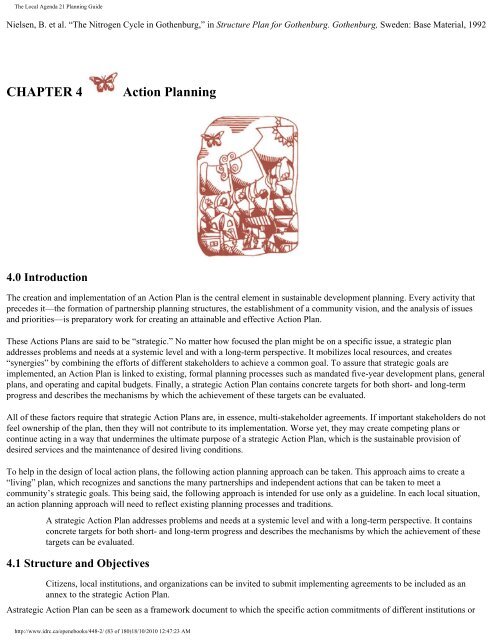The Local Agenda 21 Planning Guide - Democrats Against UN ...
The Local Agenda 21 Planning Guide - Democrats Against UN ...
The Local Agenda 21 Planning Guide - Democrats Against UN ...
Create successful ePaper yourself
Turn your PDF publications into a flip-book with our unique Google optimized e-Paper software.
<strong>The</strong> <strong>Local</strong> <strong>Agenda</strong> <strong>21</strong> <strong>Planning</strong> <strong>Guide</strong><br />
Nielsen, B. et al. “<strong>The</strong> Nitrogen Cycle in Gothenburg,” in Structure Plan for Gothenburg. Gothenburg, Sweden: Base Material, 1992<br />
CHAPTER 4<br />
Action <strong>Planning</strong><br />
4.0 Introduction<br />
<strong>The</strong> creation and implementation of an Action Plan is the central element in sustainable development planning. Every activity that<br />
precedes it—the formation of partnership planning structures, the establishment of a community vision, and the analysis of issues<br />
and priorities—is preparatory work for creating an attainable and effective Action Plan.<br />
<strong>The</strong>se Actions Plans are said to be “strategic.” No matter how focused the plan might be on a specific issue, a strategic plan<br />
addresses problems and needs at a systemic level and with a long-term perspective. It mobilizes local resources, and creates<br />
“synergies” by combining the efforts of different stakeholders to achieve a common goal. To assure that strategic goals are<br />
implemented, an Action Plan is linked to existing, formal planning processes such as mandated five-year development plans, general<br />
plans, and operating and capital budgets. Finally, a strategic Action Plan contains concrete targets for both short- and long-term<br />
progress and describes the mechanisms by which the achievement of these targets can be evaluated.<br />
All of these factors require that strategic Action Plans are, in essence, multi-stakeholder agreements. If important stakeholders do not<br />
feel ownership of the plan, then they will not contribute to its implementation. Worse yet, they may create competing plans or<br />
continue acting in a way that undermines the ultimate purpose of a strategic Action Plan, which is the sustainable provision of<br />
desired services and the maintenance of desired living conditions.<br />
To help in the design of local action plans, the following action planning approach can be taken. This approach aims to create a<br />
“living” plan, which recognizes and sanctions the many partnerships and independent actions that can be taken to meet a<br />
community’s strategic goals. This being said, the following approach is intended for use only as a guideline. In each local situation,<br />
an action planning approach will need to reflect existing planning processes and traditions.<br />
A strategic Action Plan addresses problems and needs at a systemic level and with a long-term perspective. It contains<br />
concrete targets for both short- and long-term progress and describes the mechanisms by which the achievement of these<br />
targets can be evaluated.<br />
4.1 Structure and Objectives<br />
Citizens, local institutions, and organizations can be invited to submit implementing agreements to be included as an<br />
annex to the strategic Action Plan.<br />
Astrategic Action Plan can be seen as a framework document to which the specific action commitments of different institutions or<br />
http://www.idrc.ca/openebooks/448-2/ (83 of 180)18/10/2010 12:47:23 AM










